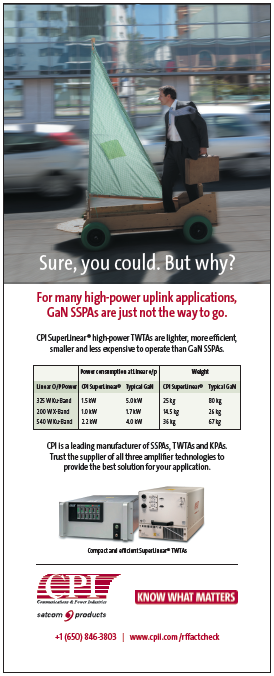The Internet of Things—or, IoT—is far more than simply the newest fitness monitor or cool device.
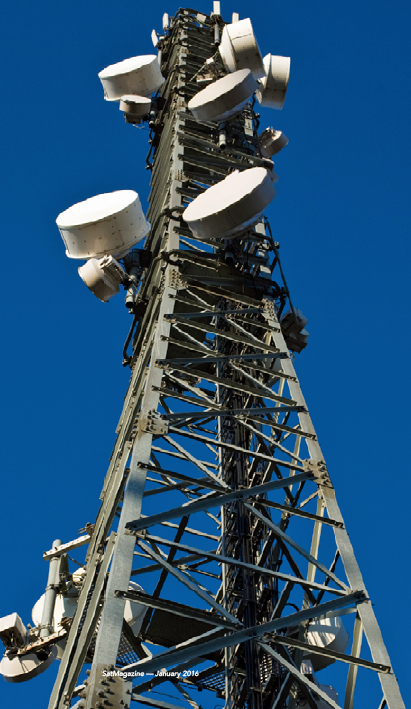
IoT is the process of transparently deploying countless sensors and devices which produce data that is then transformed into valued information.
This happens every time a consumer buys a smart device, such as a fitness monitor. The consumer knowingly enables the device to monitor an event, such as a run. In turn, the device creates data, e.g., step count, which is transported across the Internet to a
cloud application.
Analytics are then performed on aggregated data, such as a friends’ data, to create information, which could be “rankings,” which is then consumed through human or machine action, for example, to improve one’s performance to run father or faster.
This IoT process of creating, transporting, storing and acting on data for consumer applications is similar to the process needed for industrial applications. Industrial applications focus on measuring production and operational factors, distributing data to business systems and people within an organization, and directly improving business processes and profitability as a result. The Industrial Internet of Things (IIoT) is the latest catalyst to process automation. IIoT is summarized as:
• The number of sensors to monitor processes is exploding
• Connected devices transport data at higher speeds
• Cloud networks make data storage and availability scalable
• Analytics extract information from a myriad of sources
These four IIoT elements touch every aspect of an enterprise’s production or manufacturing environment and require the two organizations, Information Technology (IT) and Operational Technology (OT) which are responsible for implementing and operating IIoT information and business systems, to adopt new strategies; one strategy is
IT/OT convergence.
IT/OT convergence promotes a single view of an enterprise’s information, and process management tools help ensure that every person, machine, sensor, switch, and device in an organization has accurate information in the best form and at the correct time.
As OT products such as Programmable Logic Controllers (PLCs) and Remote Terminal Units (RTUs) become more aligned with IT infrastructure and applications, ensuring OT information is integrated efficiently with IT systems at a process level is a difficult task for many companies.
Getting IT and OT systems to work together to maximize business efficiency—all the while avoiding negative consequences, risks and pitfalls in the process—makes this task even more challenging.
However, thanks to new technologies, this process is becoming more practical and is creating numerous opportunities that are resultant in huge economic benefits when these two disciplines are integrated successfully.
Technologies That Enable IT/OT Convergence
While the economic benefits are defined by each organization, the technologies that enable IT/OT convergence are currently available and are rapidly proliferating due to IoT, Big Data and the drive to more intelligent SCADA networks. The enabling technologies include:
• High power/performance sensors, controllers, RTUs and PLCs
• Operating systems that include standard communication stacks and security protocols
• Low power Ethernet, Wi-Fi and wireless communication to sensors and controllers
• Standard protocols such as MODBUS, DNP3, IEC 60950
There are numerous companies that provide products in each of these areas. However, it is the high speed, high capacity communications that is the true enabler in IT/OT convergence.
With high data capacity, OT networks, the overhead associated with Internet and security protocols, is no longer critical to network latency or SCADA applications for wired or wireless communications. OT and IT networks are now using the same underlying network and transport layers, thereby clearing one of the fundamental barriers to convergence.
The careful selection of technology for IIoT or industrial applications helps drive the convergence of IT/OT systems. For example, in electric utilities, the rollout of Advanced Metering Infrastructure (AMI) and Distribution Automation (DA) networks is truly an OT application.
The source of the data will fuel IT/OT convergence because it is the data analytics applications—such as outage detection, fault management, prepay and others—that bring value to the Smart Grid.
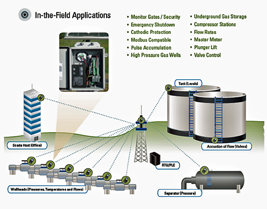
Oil & Gas “In-The-Field” IIoT Applications
In the same vein, for oil and gas production, increasing the number and type of sensors at the wellhead to monitor tubing pressures, lift arrival, flare stack operation and other necessities, provide greater insight into production and, in turn, allow SCADA systems to improve operational efficiencies and lowering production costs.
Benefits Of IT/OT Convergence
In operational networks, there is a wealth of information available from systems that are already in place. Information systems collect supplementary information from the Internet.
When these information streams are combined and used in a business process through an effectively designed communication network with carefully selected technology, the benefits are considerable and ultimately make organizations more efficient. The key benefits include:
Optimization of business processes
Decisions will be made in real-time with higher levels of confidence because more information will be available regarding the event or condition. For example, load shed or curtailment events will be based on energy availability (IT sources) and demand throughout the distribution network (OT sources). Management of an event in an IT/OT converged network will execute as a closed loop process by targeting a feeder or substation, issuing curtailment signals to customers under that substation or feeder, gauging the real-time response and repeating as required to achieve the target reduction.
Reduced operating costs
Improving business process intelligence through smarter analytics to minimize spinning reserves to compensate for variable generation sources such as wind or solar. As an example, operators are able to intelligently manage variable generation assets, which requires integrating reliable weather information (IT sources) and grid power demands (OT sources) with business process or analytics to this converged information to optimize fixed and variable generation assets.
Shorter development time and common platforms
IT and OT groups traditionally developed in two separate domains where almost all of the communication, hardware and software were specific to that domain, which made integration of IT and OT systems complex. Now, with the proliferation of communication standards, powerful processors and operating systems provide a common environment for IT and OT groups. IT and OT groups now share fundamentals in communications and network architecture, which simplifies the transport of data across systems, thus the technology divide between IT and OT is closing and becoming common.
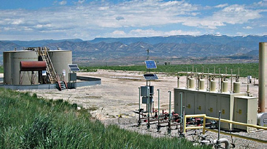
Extension policy and security across networks
In the past, many OT groups depended on standalone or siloed data networks and possibly obscurity for network security. With interconnected IT and OT networks, the entire network must be secure to minimize vulnerabilities at any single point in the combined network. Many OT products now support standard communication and security protocols. Therefore, organizations need to implement and manage policy and security measures against their entire IT and OT networks leading to standardized access and minimizing network vulnerability.
By converging IT and OT, organizations will realize these and numerous additional benefits and numerous that are specific to the organization’s business processes and IIoT strategy.
Challenges + Issues Surrounding IT + OT Integration
With identifiable business benefits and rapidly developing technologies that are closing the IT/OT divide, there are functional and operational differences between IT and OT groups that exist and complicate integration or convergence.
IT and OT groups typically have fundamentally different charters, focus and personnel within their respective organizations. The challenges to
IT/OT convergence are not the sensors, hardware, software or technology, but how each group perceives each project or opportunity and, in turn, the solutions, which are skewed by their respective domains. The challenges in IT/OT convergence and project execution are:
• Project ownership
• Communication between groups and with stakeholders
• Adapting or harmonizing conflicting organization needs, process and policy into a single and common structure
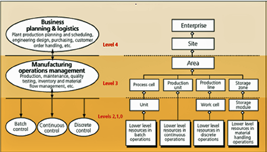
Hierarchies per ISA-95.
Project ownership and understanding will be called into question because of historical experiences between the groups. Some of the fundamental differences within an organization may be:
• OT has largely been outside the highly pragmatic world of IT and employs process specialists such chemical or electrical engineers. OT likely manages projects, networks and solutions, with the focus of keeping production rand real-time operations running. Additionally, OT employs vendor or proprietary hardware and software that is specific to a production process and may not meet the security standards of the IT organization.
• IT has been maintaining business systems and communication networks with five or more nines of reliability and employs computer and IT specialists. IT typically plans and manages rollouts and upgrades in a very methodical manner leading to longer rollouts. IT is solidly based on communication standards and centralized operations and it may be looked on as a “roadblock” to rolling out OT applications.
In order for IT/OT convergence to be successful, communication is essential and in turn, there needs to be a clear understanding of each group’s roles.
Considerations
As organizations work to benefit from the convergence of IT/OT functions, stakeholders, product owners and organizational managers must continue to understand differences between IT and OT while embracing the similarities.
Typically, IT owns the corporate strategic direction, policy, security and implementation of networked communications and business systems.
OT, on the other hand, owns process definition, device selection and information flow in order to optimize and manage production systems.
Product owners own the definition of the business process and the goals for the IT/OT project.
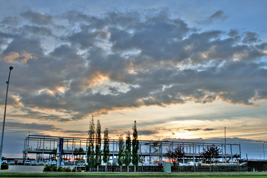
A framing construction project in Alberta, Canada, using IIoT technologies.
To move any project forward, project management is essential. The IT group is the likely choice for overall management of IT/OT convergence projects because of experience with centralized management, network security, information storage, and business systems. After all, the resulting product of an IT/OT project is improvements to business process resulting in cost reduction and harmonization of corporate policy and security.
As these two areas may be at occassionally at odds, organizations working on IT/OT convergence need to clearly define stakeholders, areas of ownership, and so on.
Managing The Interworking Between IT + OT
Now that the benefits and challenges of IT/OT convergence have been defined, an understanding of the basics on management of this convergence is critical.
Therefore, a general framework for IT/OT projects is needed to harmonize the roles and divide the joint project or application into manageable elements or layers, and align the elements with the business goals or drivers. The general IT/OT project approach is:
• Determine the business goals or drivers
• Develop the implementation roadmap since IT/OT projects are likely multi-phase implementations
• Develop the business and get stakeholder buy-in
• Develop the business process workflow and use cases
Once the business process flow and use cases are well known, the detail elements or tasks of the project are defined. These include the data and interfaces for the various actors to interact.
It is clear that OT owns the micro-vision and implementation of any solution and IT owns the macro-vision and implementation of the same solution. OT groups work from the sensor to data collection to process control to transfer of data to a database.
Conceptually, OT works from the bottom up, while IT groups work from the business process to data storage to data transport across dedicated networks or corporate networks. Conceptually, IT groups work from the top down. Having a framework to align project interface, roles and functions is vitally important.
ISA-95 is a multilayer standard or framework that defines IT/OT convergence as 5 layers with OT working layers 0 (sensing and manipulating process) to layer 3 (managing work flow) or upward, and IT working layer 4 (managing business activities such as ERP or MRP) to layer 3 (establishing basic schedules) or downward.
While the ISA 95 standards are not yet complete, the division and allocation of the overall IT/OT integration is a model and serves IT and OT groups as they define projects’ scope, divide applications or tasks, and define interfaces and communications.
IT/OT Integration Dangers + Pitfalls
While OT systems are changing and are becoming more aligned with IT systems through the use of standard interfaces and security protocols, OT and IT domains are still worlds apart and require a keen understanding of their respective differences. For example, IT groups may deploy hundreds or thousands of network devices, such as computers, routers and switches, to their enterprise networks each year. There is a market expectation that these vendors will release products that present standard interfaces and comply with security protocols, in addition to the expectation that these vendors will maintain their operating and security systems with regular patches and updates.
On the other hand, OT devices are typically specific to an application or task and likely lower in product volume. As a result, patches and upgrades may be slower in arriving. In addition, process programs may be developed on a PLC or RTU that may use features specific to a product release. As a result, maintaining and upgrading OT systems may present a level of fragility IT groups are not familiar with or may not comply with the necessary security safeguards.
Therefore, IT and OT must communicate and work closely to understand the nuances of application specific devices and hardware, how these devices may influence network operation and, in turn, policy. Pitfalls of IT/OT convergence are a challenge that many organizations will face, but with the best-fit technology and good relationships between the OT and IT groups, consistent communication with business owners and stakeholders, they can be avoided.
The Benefit Of Convergence
Worldwide IIoT markets are exploding. In order to benefit from the proliferation of data and its transformation into information, companies need an IoT strategy that includes IT/OT convergence in addition to Big Data.
As technology changes continue to close the divide between IT and OT systems, IT/OT convergence will see shorter development cycles, higher levels of policy and security administration and smarter business analytics. These are inherent gains of IoT and Big Data markets. In short, technology, hardware, software and communications are not likely the key challenges to IT/OT convergence.
The key challenge for many organizations will be management of IT/OT convergence projects due to the inherent differences in their IT and OT groups because of how each sees the problem and solution. With planning, ownership and clear communication among all of the groups and stakeholders, IT/OT convergence can certainly be realized, along with the potentially huge gains for any firm’s bottom line.
freewave.com/


